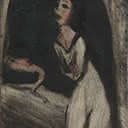Lady McBeth
40.5 x 32.5 cm
est. $50,000 - 75,000
PROVENANCE Private Collection, Auckland Acquired from Beatrice Grossman, 1988
LITERATURE Ian Wedde [ed.], Fomison - What Shall We Tell Them?, City Gallery, Wellington, 1994, Supplementary Catalogue, p.167
By 1988 when this work was made, Fomison's health was deteriorating, necessitating hospitalisations. Despite this he worked steadily towards a solo exhibition at Gow Langsford Gallery which opened in July 1989. It would be his last. The NZ Herald reviewer commented that the paintings were small and featured tormented and melodramatic subjects. He pointed out the literary references evident such as a portrayal of King Lear, who in Shakespeare's play becomes homeless, destitute and insane before dying. Well-versed in Shakespearean literature, Fomison had previously painted Shylock in 1986 and the bard himself as a clown in 1980.
This painting features one of the main characters from Shakespeare's play Macbeth, a tragedy in five acts, which was written in 1606-7. He based the story on the real Macbeth who took the throne in 1040, after killing his cousin King Duncan I in a battle near Elgin in the Moray district of Scotland. In the play, the ambitious Lady Macbeth exhorts her husband to commit murder but is then driven mad by guilt and kills herself. In Fomison's painting only the faintest traces of pink on the cheek and neck relieve the pallor of stricken Lady Macbeth. Figures in his paintings often appear as if rubbed into the canvas, and his restricted palette makes the works resemble the grisaille (grey paintings) of historical European painters. Lady Macbeth's anguish is accentuated not only by her bent posture with arms hugged tight across her torso but also the dark slash of her open mouth, and the heavy lines which demarcate the shape of her white-gowned figure. She is regarded solemnly from the bed by one of the medieval homunculus figures that make frequent appearances in Fomison's work.
Curator and writer Ian Wedde has suggested that Fomison had an enduring interest in depicting sinister and deadly women such as Cleopatra and sphinxes with devouring mouths, which culminated in his portrayal of Hine-Nui-Te- Po luring Maui to his death. Wedde points to the 1979 book by Patrick Bade on fin-de-siecle femme fatales in Fomison's library as a source. Yet consider how the little creature observing Lady Macbeth behaves less as a demon familiar to a witch, than as a sombre witness to her descent into madness and suicide. Fomison's paintings often remind us of historical recurrences, as well as the need for empathy.
LINDA TYLER





